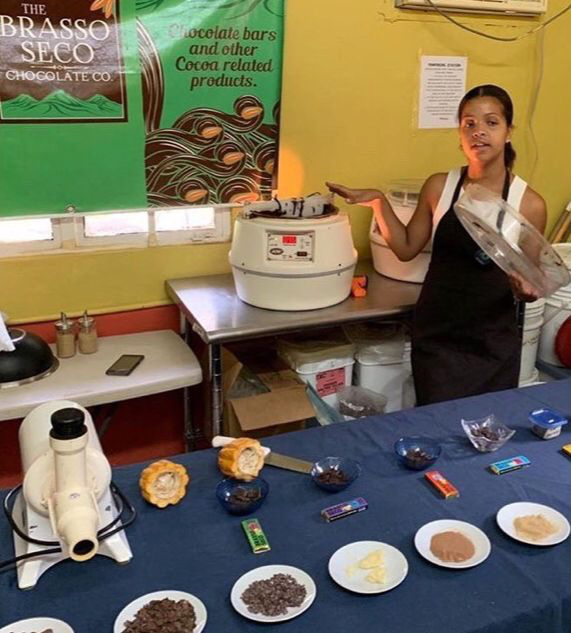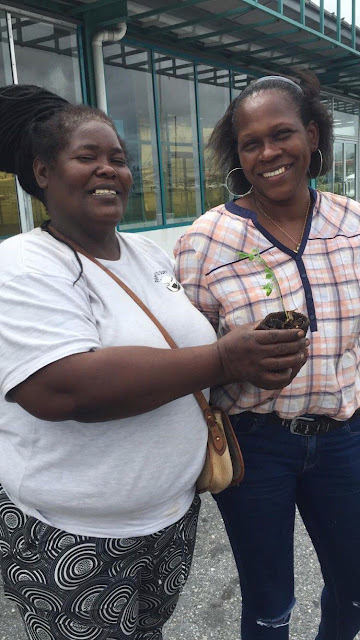New Cocoa Challenges
The cocoa industry over 100 years ago was focused on export of beans, mainly to Europe. Today, new entrepreneurs have restarted the Trinidad and Tobago cocoa industry at home with chocolate making. Pat Ganase reports on some 21st century cocoa challenges.
Gillian Goddard’s home-based enterprise started with drying bananas and processing cocoa nibs ten years ago. She learned to make chocolate – from online demonstrations – and has extended her influence to empower individuals and communities. Today, Goddard and the Alliance of Rural Communities are dealing with a shortage of cocoa beans to keep their enterprises going, to ensure the health of communities and deal with the bigger issues of climate change.
“We called the meeting of cocoa and chocolate producers and associated institutions because our #1 issue is solidarity. We have a common shared experience. In the face of institutional silence, we need a community response,” said Goddard, founder and systems thinker of the Alliance of Rural Communities (ARC). The online meeting took place on July 5 and about 40 persons from the cocoa sector were on the call.
By way of introduction, Goddard shared, “ARC started in 2015 to encourage, train and equip communities to become economically sufficient through chocolate making practices. ARC today is in three communities in Trinidad and Tobago, as well as in St Lucia, Dominica, Guyana and is a member of the Global Pan-African group in 14 countries. ARC established an LLC as well as Conservation, Environmental and Tourism sub-groups. ARC Marketplace represents about 200 products, and were innovators in contactless deliveries during covid. ARC Co Create is soon to open an activist space in Tunapuna.”

Mellisa
Hernandez from Brasso Seco
From 2018 to 2019, Goddard said, ARC revenues based on chocolate doubled. They were set to double again in 2020 but sales declined because of the covid lockdown. In 2022, expecting recovery, revenues did not rebound because of the shortage of cocoa beans. In 2023, beans in storage have been used up.
Is there a reason for this decline? Could it be that increasing demand has finally met the limit of the capacity of production from the estates? Are the changing weather patterns contributing to poor flowering, poor pollination? Is rainfall and excess humidity responsible for fungal diseases? There have been claims of as much as 75% declines in harvests. “The reality is that many of us now depend on chocolate to make our living; and this year we are struggling.”
Surrendra Persad, from Persad’s Cocoa and Chocolate in Siparia – processor of cocoa powder, cocoa butter and chocolate – said, “We buy cocoa from all over the country. The price of beans has risen from $28 to $50 per kilo. It seems to me – from what is available – that yields have gone as low as 10%. I usually buy 25 tonnes of beans in a year. So far, I’ve bought 1500 Kg for this year (six months) and I can’t get any more to buy. I am bringing in liquor to keep the business alive.” (Chocolate liquor is a paste produced from roasted and ground cocoa beans.)
Wayne Cezair from the Cocoa Pod which sells a range of cocoa products, estate chocolates as well as other cocoa-derived item, said, “Most of the estates have experienced serious declines, whether from parrots or squirrels or other pests. The supply has dropped off considerably; I may be getting about 25% of what I have in the past couple years.”
Chocolate
made by ARC communities. Each with the distinctive flavour of cocoa of the
area. Photos
courtesy the Alliance of Rural Communities.
TT
Fine flavour cocoa designation

The Cocoa Development Company of Trinidad and Tobago Ltd (CDCTTL) was established in 2013 as a wholly owned government company. It functions as an agency of the Ministry of Agriculture.
Jacqueline Rawlins, chairman of CDCTTL, attended the meeting. She said, “Over the last three years, we are seeing declines due to many underlying issues that have not been addressed. There’s a shortage of planting stock. The majority (75%) of trees are over 50 years old. Soil fertility is a problem. There’s the high price of labour. Since 2022, the yield has been 200 metric tonnes, or less.
“We have a serious concern about allowing the import of beans, mainly the quality of beans. One country that started to import beans lost their status as a ‘fine flavour’ region. We don’t want to affect the appeal of the product from our region. The CDC and CRC (Cocoa Research Centre located at The UWI St Augustine) recommendation is to allow import of liquor over a six-month period. Our ICCO status may be affected if we import beans.”
Fine flavour cocoa producing countries are designated by the International Cocoa Organization (ICCO) an inter-governmental organization established in 1973.The Organization comprises 52 member countries, of which 23 are cocoa-exporting countries and 29 are cocoa-importing countries (mainly Europe). TT is one of 23 countries designated fine flavour cocoa producers.
“Liquor is not something that I want to work with,” said Isabel Brash, owner and chocolate maker at Cocobel Chocolate, “that’s cocoa already processed, and we have to pay for the extra processing which may not suit the flavours we wish to achieve. Why not beans which are dried – the way we export cocoa beans. Part of the art and love that goes into chocolate making is in roasting the beans. Why can we not import beans from neighbouring Caribbean states – Grenada, St Lucia? I would use beans from another island and label accordingly, Cocobel chocolate with Grenada beans etc. In this way, we celebrate each other’s chocolate across the Caribbean.”
Chocolate
maker Kareem Williams from Brasso Seco
Revitalisation on the cocoa estate
Goddard shared, “ARC has been harvesting beans ourselves on estates that allow us. There’s no labour shortage. We need another forum for farmers to talk to each other. We have been teaching cocoa growers how to make chocolate. When we have to get on the land, we have collaborative harvesting methods. We buy wet beans. We function as a collective, it’s an approach that provides buffers – like flexible hours, redundancy.”
Michael and Jacinta Milne operate Bethany Estate between Brazil Village and Talparo. They have adopted a holistic approach to agriculture over 30 years. “Over the last three or four years, we have seen an increase in pests; in rainfall. There is a reduction in yields. We recently put in new beds in a syntropic environment. Within two years, young cocoa trees grew from one foot to five, and look like they will start producing pods soon. What is the syntropic environment? We build the soil with compost of fruit and vegetable cuttings, pruned vegetation and bio mass, fallen trees, organic matter, coconut shells, clean cardboard around the trees. This aids in water retention. We are working with a 10’ by 10’ grid for cocoa and intercropping with other trees and plants. We have a food forest with bananas and citrus, pineapple, pawpaw, passionfruit, soursop, sorrel, pigeon peas and topi tambu.”
Sarah Bharath, a cocoa consultant providing support for field production and post harvest technology, said, “We need a complete overhaul of the systems we have for cocoa. We have fundamental issues at soil level; soil remediation is necessary to build in resilience which is the ability of the system to self-regulate to optimum production. We have to consider the biology of the plant; then rainfall, pollination and the varietals. Plus, there are location specific challenges so we must be careful not to generalize.”
Goddard said, “In the 14 countries I am associated with, no one else is having this problem. In other parts of the Caribbean, neighbouring islands are not having this problem. For many of us, this is our livelihood. Everybody is looking for beans. This is not an academic or institutional problem.”

Chocolate
makers Ethelreda Lewis from Cushe and Maria Barker from Grande Riviere
Keeping cocoa at home
Elizabeth Montano representing the (Machel) Montano’s cocoa and chocolate company said she was happy to hear that ARC could help revitalize old cocoa estates. She suggested, “Let us keep our cocoa at home. Why not approach the local estates that are exporting to support the local chocolate makers by selling our beans at home. We have to help each other – charity begins at home. We need to be innovative, while we rehabilitate the old estates.”
Donna Mora, Lopinot Tourism Association and Lopinot Chocolate Company, said, “We reached out to the Venezuelan Embassy. Our cocoa beans are a hybrid of Criollo and Forastero which came from Venezuela… Perhaps we could import beans from Venezuela.”
Goddard said that this forum arose from the need to know what’s going on. There are many emerging issues, “We need to create awareness and change around climate unpredictability. Immediately, our beans are running out, our livelihood is at risk. There are many separate issues and constituencies: farmers, processors, chocolate makers. We need the support of the institutions; and our understanding as a community.
“Cocoa is an anchor crop in a system - it’s not the system – that should be about health and wellness. What are the fundamental problems to be solved? Not just chocolate problems, what will solve crime, uninformed parenting? What will create resilience?”


